Regular checkups are key when it comes to keeping your teeth, eyes and spine in optimal condition.
| 2019 Q4 | story by Bob Luder | photos by Steven Hertzog
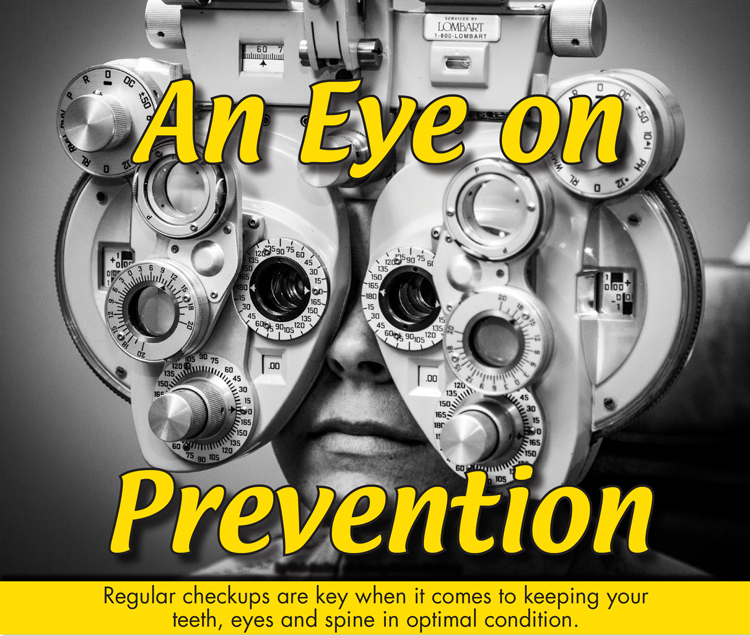
Medical and health specialists. They’re those practitioners, such as dentists, optometrists and ophthalmologists, chiropractors and podiatrists, who most see on a regular basis but many often take for granted.
Those who are good arbiters of their own health presumably visit the dentist office twice every year for a six-month checkup. They most likely get their eyes checked once a year. And they visit a chiropractor or podiatrist whenever an issue develops with pain in the back or feet.
There are those, however, who neglect these basic preventive steps for vital body parts. They go to the dentist only when a tooth or teeth are hurting so badly they can’t eat or sleep. They avoid the eye doctor until their vision becomes so blurred they can barely read or drive. They live with back pain until it gets so severe they can barely walk or stand upright.
These folks proceed at their own peril. As we’re learning more all the time, something as basic as regular prophylactic dental, eye and back care can prevent much more serious problems down the road, which might require medical treatment or even hospitalization.
“We’re learning more all the time about how the mouth can be a great eye into the general health of the body,” says Dr. Brad Adams, DDS, a dentist at Free State Dental. “Bacteria in the mouth can play a big impact on other areas of the body. A lot of heart issues can be linked back to what’s found in the mouth. The same with diabetes.”
Because of these findings, Adams says he feels that most people are very receptive to keeping regular appointments for checkups two to three times per year.
“Even if it’s just to check blood pressure,” he says. “We can catch and keep an eye on things that can affect general overall health.”
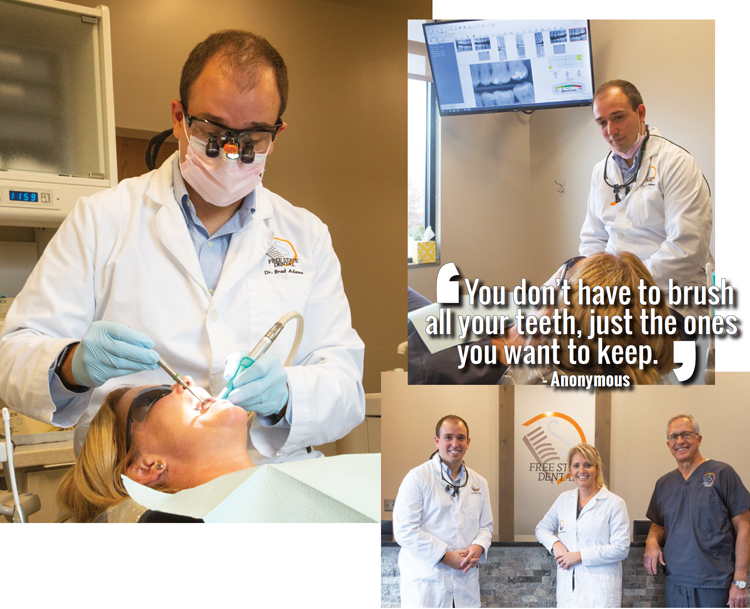
clockwise: Dr. Brad Adams conducts a dental exam on a patient; Dr Adams explains to a patient their x-rays; Drs Adams, Newkirk and Van Blaricum of Free State Dental
Care for the Chompers
When it comes to good preventive dental health, Adams says there are two major components he stresses to his patients. The first is maintaining a good diet. That might beg the question: What does keeping a trim waistline have to do with the health of my teeth? Plenty as it turns out. Adams says the American public has adopted diets high in sugar and acid content. The most prominent culprit of this is the consumption of sodas and juices.
“Most people think fruit juices are good for you,” Adams says. “But many of those are very high in sugar content.”
The worst offense, Adams says, is buying a large soda in the morning and then sipping on it all day. That allows the sugar in the soda to cling to the teeth all day, which causes decay. And diet soda? That’s bad, as well.
“It’s true diet drinks have less sugar,” Adams says. “But diet beverages have high acid content, which can erode enamel and wear on teeth.”
The second component, of course, is maintaining and reinforcing good dental hygiene. Typically, that includes brushing twice a day and flossing regularly. Adams strongly recommends using an electric toothbrush over a manual.
“That takes hygiene to the next level,” he says.
Even with all that—staying away from food and drinks high in sugar content and maintaining strong dental hygiene habits—it’s still important to visit the dentist at least twice a year for checkups. Adams says he and the two other dentists at his practice perform routine procedures such as cleanings and X-rays, but also spend a lot of time with patients on education, teaching good hygiene practices and why they might have developed an issue, or how to avoid one.
For instance, Adams says, most people don’t know the bacteria we inherit is different person-to-person. That’s why someone might develop cavities and other oral issues more easily, while others can seemingly have poor dental hygiene habits yet suffer few problems or issues.
“I think most people know now that they should be taking care of their teeth,” Adams says. “Whether that happens is sometimes another thing.
“We’re constantly trying to educate on taking care of teeth to improve quality of life,” he continues. “We’re constantly trying to fight that good fight.”
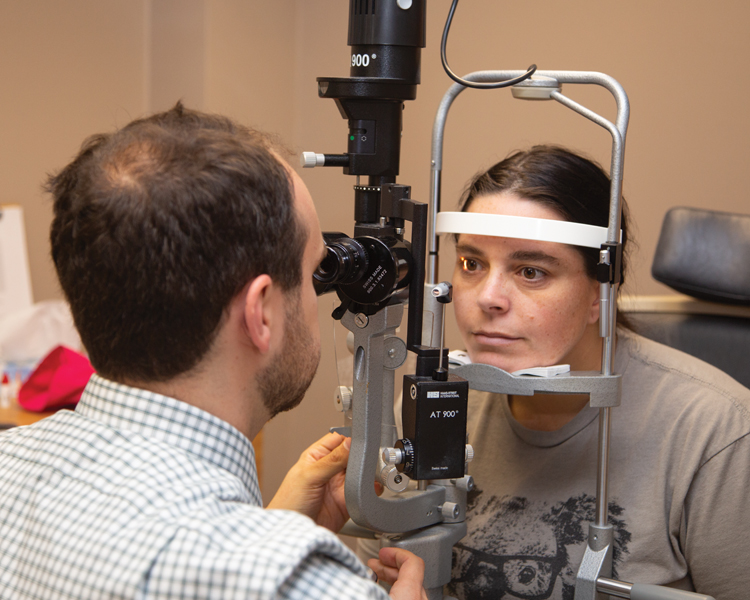
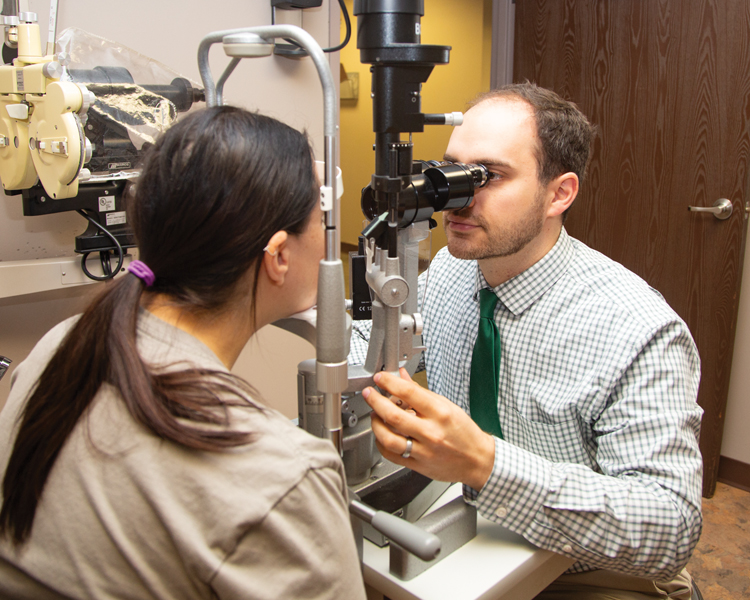 Dr. Bilal Farhat, M.D. of Lawrence Eye Care Associates gives an eye exam to his patient
Dr. Bilal Farhat, M.D. of Lawrence Eye Care Associates gives an eye exam to his patient
The Eyes Have It
As much as people can neglect or put off seeking regular, proper dental checkups, folks can be even more negligent when it comes to caring for one of the organs used most in day-to-day life: the eyes. That’s probably because problems with the eyes often can seem minor, even unnoticeable, until they become so acute as to require urgent care or even surgery.
But it’s just as important to receive regular eye checks as it is to visit the dentist or any other specialist.
“Everyone should have their eyes checked with full dilation once a year, especially if you’re over 50,” says Dr. Bilal Farhat, M.D., an ophthalmologist at Lawrence Eye Care Associates.
Those eye exams, performed by ophthalmologists or optometrists, become crucial in searching for eye diseases that might start in childhood and grow more with age, he explains. Prior to starting school, children should have a complete eye exam and be checked for glasses since missing something might lead to permanent vision loss and learning difficulties.
With increasing age, your eye doctor checks for conditions such as the development of cataracts, a clouding of a normally clear lens; glaucoma, an eye condition involving eye pressure that damages the optic nerve; and macular degeneration, which typically is genetic or age-related. Many of these eye conditions have slow onset leading to permanent, unexpected vision loss.
“If you’re diabetic, it’s a requirement from a primary doctor to have an annual eye exam for diabetic retinopathy,” Farhat says. A healthy diet and exercise, and controlling blood sugar, blood pressure and cholesterol are just as important for the eye as the rest of the body.
Patients also are checked for more simple issues such as the need for vision correction with glasses or contacts, and dry eye.
There also are several measures people with sensitive eyes can take at home to help alleviate discomfort and blurred vision. Many people suffer from dry eye, and there are a variety of over-the-counter drops that help lubricate the eyes and alleviate those symptoms. Farhat says warm compresses, eyelid scrubs and in-home humidifiers also can be of help. Sunglasses also are beneficial, as they can decrease light sensitivity and provide protection against ultraviolet light.
Vitamins also might help with eye and vision health, such as over-the-counter eye vitamins for macular degeneration and omega-3 fish oils for dry eye.
Those who wear contact lenses should maintain good hygiene practices. Never sleep, bathe or swim in them. Change as directed. And something that many contact-wearers forget: Cases should be kept clean.
Never wash cases or contacts with tap water since it can contain infectious organisms, Farhat cautions.
With increasing age, everyone eventually develops cataracts causing decreased vision and glare. Cataract removal is the most common surgery performed in medicine. An eye doctor will monitor for cataracts as part of an annual exam, and an ophthalmologist can help patients see better when cataracts start to affect everyday life.
Of course, everyone should remain cognizant of any changes in vision that can come with aging, genetics or disease. If treatment is needed, Lawrence Eye Care Associates offers a range of services, all available in Lawrence, which include cataract removal, cornea transplantation and LASIK surgery, which reshapes the cornea to change the way light is focused within the eye relieving the need for glasses or contacts.
“People should check their family history,” Farhat says. “Those people that have a family history of eye disease should be extra vigilant with their eye exams.”
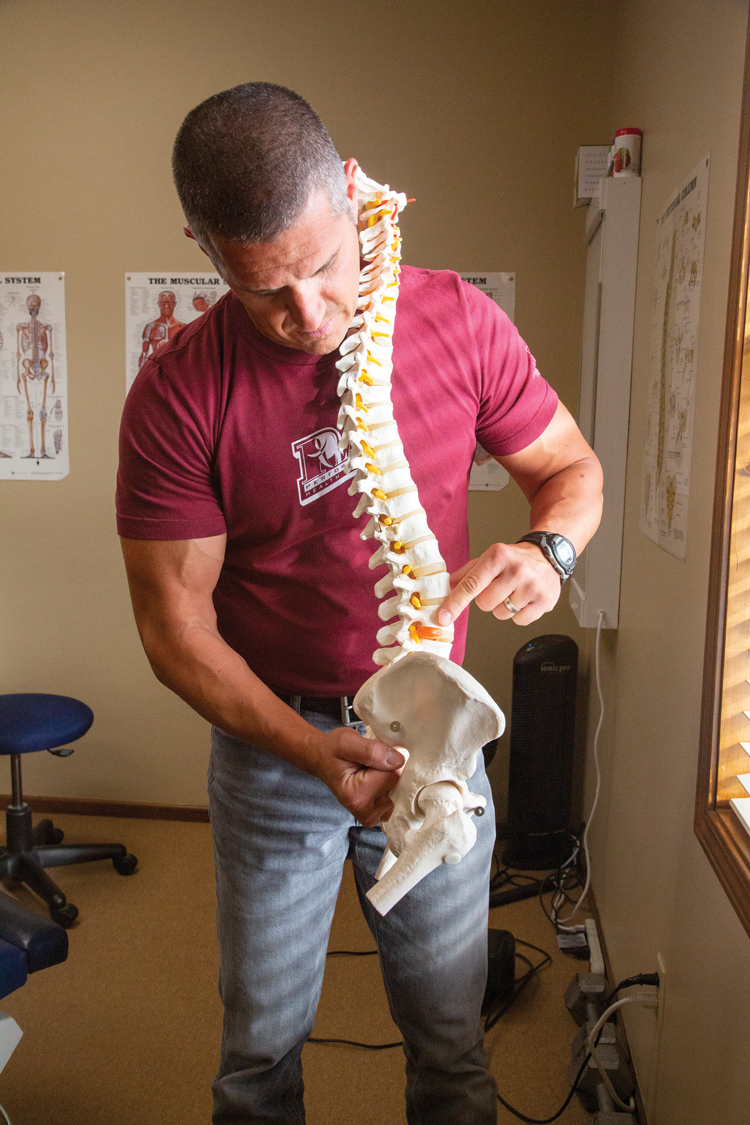
 Dr. Rob Jones, D.C. owner of Peak Performance Health Center uses a spine model to communicate to his patient the inner mechanics of the human spine. Dr. Jones works with his patients to perfect proper form to get the maximum results out of physical therapy and exercises.
Dr. Rob Jones, D.C. owner of Peak Performance Health Center uses a spine model to communicate to his patient the inner mechanics of the human spine. Dr. Jones works with his patients to perfect proper form to get the maximum results out of physical therapy and exercises.
Strong Spine, Core to Good Health
As anyone who’s suffered from it can attest, back pain or any affiliated pain from a bad back can make even the simplest exercise—like getting out of bed—torturous. For years, chiropractic health practices (the manipulation of vertebrae to ease pressure on nerves) were seen by many as medical outliers or worse. Long-term physical therapy and massage was considered more “legitimate” health practices.
During the years, those opinions have largely shifted, and chiropractic is more widely accepted as a practical and effective form of pain relief and long-lasting health, especially when combined with the aforementioned physical therapy and massage.
Dr. Rob Jones, D.C., of Peak Performance Health Center, combines all of those treatments in helping those in need, including some University of Kansas athletes, with back and structural issues.
“I guess you could say I’m kind of a chiropractor/physical therapist/athletic trainer/strength coach,” says Jones, whose book, “Protect Your Back 101,” was published last year. “I use chiropractic adjustments if necessary, but I also prescribe a lot of home self-care. Things like proper stretching techniques and proper cooling down from workouts.
“I set my practice up where I’m diversified,” he continues.
Jones also incorporates a technique known as active-release therapy (ART), which uses deep-tissue massage along with movement of injured or sore muscle fibers, tendons and ligaments. The manipulation of those sore fibers allows them to loosen and heal more quickly and properly.
“I recognize where there’s tightness and where there’s pain,” Jones says. “I try to prevent that first then seek to heal it.”
Jones says about 80 percent of the patients he sees suffer from cumulative trauma or microtrauma—issues that mount up after a long period of over- or misuse—as opposed to macrotrauma, which includes sprains and ligament tears. He says he has two goals when he treats patients: get them out of pain, then help them so they don’t have to keep coming back.
He believes in functional movement, or moving the joints and limbs correctly so they function properly and remain healthy. Thus, it’s not uncommon to catch Jones using his cell phone camera to record patients walking up and down his hallways. In watching his patients’ walking gates and movement in slow motion, he can detect where imbalances or imperfections might exist.
“I’m kind of known around town as the chiropractor who does different things,” he says. “I would hope it’s the future (of chiropractic medicine).”
Jones also hopes it’s a positive step in gaining even more credibility for a medical field that’s becoming more mainstream all the time.
“In many areas in the medical field, chiropractic is still thought of as voodoo,” he says. “But I’ve had doctors buy into what I do. They like the fact that it’s therapy-based. Medical doctors are the gateway to health care, and they seem to be more receptive to chiropractors who use a more rehabilitation model.
“I think we’re garnering more respect for the profession,” he continues. “There’s a ton of good research out there. And it’s showing that it’s effective.”
